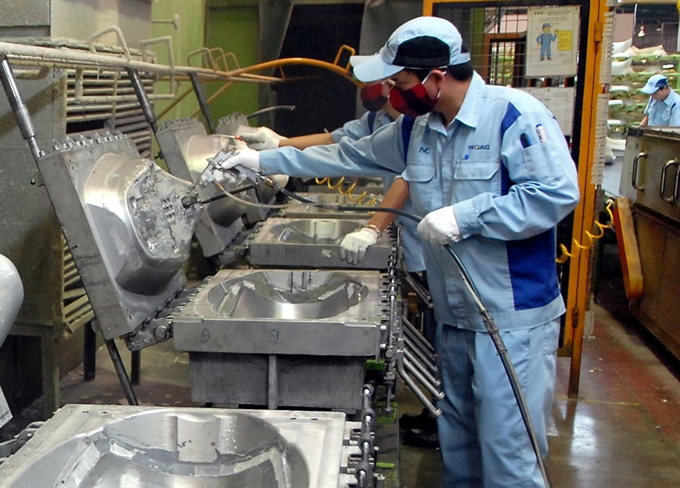Review of FDI projects needed: former minister
 |
| A production line of INOAC Việt Nam - a Japanese invested company in the Quang Minh Industrial Zone in Hà Nội. In the first seven months of this year, FDI recorded a year-on-year increase of 47 per cent with a total registered capital of US$12.8 billion, effectively reversing a decline during the same period last year. -- VNA/VNS Photo Danh Lam |
Phan Hữu Thắng, former head of the Ministry of Planning and Investment’s Foreign Investment Agency, has also called for a comprehensive review of foreign direct investment (FDI) projects in different fields, industries and localities.
In an article penned for the Thời báo Kinh tế Việt Nam (Việt Nam Economic Times) newspaper to mark 30 years of Việt Nam receiving FDI (2017), Thắng said past experience would help the country set new development trends for foreign investment in the context of changes in the international and regional situations.
These included terrorism, incursions into territorial waters, complicated relationships among big countries, slow growth of the global economy, he added.
“It is a must that in the times ahead, State management focuses on how to efficiently use FDI to sustainably develop the country’s society and economy,” Thắng said.
In making FDI decisions, Việt Nam should not just see it as a foreign capital resource for development, but also consider its implications for the “environment, national security, culture, national economic independence and self-control,” he stressed.
He said the State should limit to the maximum potential threats to economic independence, ensure social order and security (he referred to the Australian Government refusing to let Chinese investors participate in an electricity grid project), define nationality of investors, establish a balance between foreign and domestic investment, and draw up a list of sensitive fields and industries that cannot be opened to foreign investment.
Việt Nam should focus on attracting FDI into high-tech agriculture and services sectors including tourism, and limit it in real estate, logistics, retail and wholesale sectors.
“Such industries should be given to domestic investors,” he said.
Resurgent FDI
In the first seven months of this year, FDI recorded a year-on-year increase of 47 per cent with a total registered capital of US$12.8 billion, effectively reversing a decline during the same period last year.
Over 70 per cent of the registered FDI was in the manufacturing and automation industry.
The article also noted “new trends” of Vietnamese business participation in exporting high-tech production chains, product research and development, and clean and new energy construction.
It cited as examples the 4P company having its own plant to produce chipsets within LG Display Hải Phòng’s production chain, the Samsung R&D centre in Hà Nội for high-tech electrical, electronic and telecommunication products, and the wind power plant in southern Trà Vinh Province.
The export turnover of FDI projects including crude oil was $70 billion, accounting for 71 per cent of the national figure.
It is expected that this year, FDI will surpass targets for both registered and disbursed capital by around 5-10 per cent at $25 billion and $15 billion respectively (compared to $24 billion and $14.5 billion in 2015).
“Relevant authorities should pay attention to the number of small-size projects with a capital of under $1 million. The number is increasing as was the case 30 years ago when Việt Nam started receiving FDI,” Thắng said.
The number of such projects has been estimated to account for around 60 per cent of this year’s FDI and “this situation will require more research in the coming time as we examine FDI efficiency,” he added.
Thắng also stressed the environmental impacts of FDI projects, highlighting the example of Formosa.
Many FDI projects were still applying backward technology, consuming huge amounts of energy and causing environmental pollution, he said, blaming the situation on “limited” State management of FDI and poor environmental protection controls.
He also noted that many long-term problems continued to plague the local economy, including low localisation in manufacturing and automation, weak part supply industries, and weak links between FDI projects and domestic businesses.
Eighty per cent of FDI enterprises were still under 100 per cent foreign ownership, he said.
Thắng suggested that Việt Nam pays more attention to open sources as it tries to access advanced technology.
| RELATED CONTENTS: | |
| ‘Foreign-invested project’ doesn’t always mean ‘foreign-financed’ | |
What the stars mean:
★ Poor ★ ★ Promising ★★★ Good ★★★★ Very good ★★★★★ Exceptional
Latest News
More News
- Mitsubishi Estate launches Logicross Hai Phong - a milestone in logistics evolution (November 20, 2024 | 14:32)
- Semiconductor workforce partnerships deliver industry-relevant training (November 20, 2024 | 10:58)
- German Quickpack to invest $31.7 million in Long An province (November 20, 2024 | 09:31)
- Foreign-invested enterprises drive logistics investment in the southeast region (November 20, 2024 | 09:27)
- Chile visit underscores trade benefits (November 19, 2024 | 10:00)
- Trump’s second term impacts sci-tech activities and industry 4.0 technologies (November 18, 2024 | 10:00)
- Vietnam eyes nuclear revival to bolster energy security (November 14, 2024 | 16:46)
- Kyokuyo completes $13.5 million seafood factory in Vietnam (November 14, 2024 | 12:19)
- VinFast receives $3.5 billion funding from Vingroup and Pham Nhat Vuong (November 14, 2024 | 06:38)
- Localities sprint to reach FDI targets (November 13, 2024 | 10:00)















 Mobile Version
Mobile Version